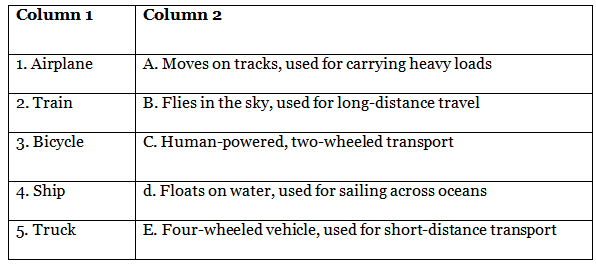Means of Transport - 2 Class 1 Worksheet EVS
Q1: Multiple Choice Questions (MCQs).
(i) What is a mode of transport?
(a) A type of food
(b) A way to communicate
(c) A way to move from one place to another
(d) A type of toy
(ii) Which mode of transport can fly in the sky?
(a) Car
(b) Boat
(c) Airplane
(d) Bicycle
(iii) Which mode of transport is used in water bodies like rivers and seas?
(a) Bus
(b) Train
(c) Ship
(d) Scooter
(iv) What mode of transport can you ride on two wheels?
(a) Bus
(b) Motorcycle
(c) Train
(d) Truck
(v) Which mode of transport is pulled by horses and can be seen on the roads?
(a) Bicycle
(b) Helicopter
(c) Submarine
(d) Cart

Q2: Match the modes of transport with their descriptions.

Q3: Choose the correct answer to fill in the blanks.
(i) A __________ can travel in the sky and carry people to different places.
(ii) A __________ is a small vehicle with two wheels that you can pedal to move.
(iii) A __________ is a large water vessel that sails on oceans and seas.
(iv) A __________ is a vehicle with four wheels, used for transporting goods.
(v) A __________ runs on tracks and carries passengers from one station to another.
Q4: Write TRUE or FALSE for given statements.
(i) A bicycle has four wheels.
(ii) Ships are used for traveling on land.
(iii) An airplane can fly high in the sky.
(iv) Trains run on water.
(v) Trucks are used for carrying goods.

Q5: Short Answer Questions.
(i) Name two modes of transport that can travel on water.
(ii) What is the purpose of an ambulance?
(iii) How is a helicopter different from an airplane?
(iv) Why is a bicycle considered an eco-friendly mode of transport?
(v) What safety measures should you follow when riding in a car?
|
17 videos|85 docs|24 tests
|
FAQs on Means of Transport - 2 Class 1 Worksheet EVS
| 1. What are the most common means of transport? |  |
| 2. How does transportation contribute to pollution? |  |
| 3. What are the advantages of using public transportation? |  |
| 4. How does transportation impact the economy? |  |
| 5. What are the challenges faced by transportation systems? |  |

|
Explore Courses for Class 1 exam
|

|


















